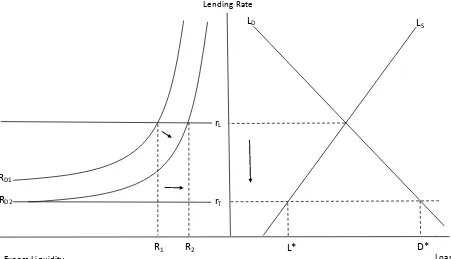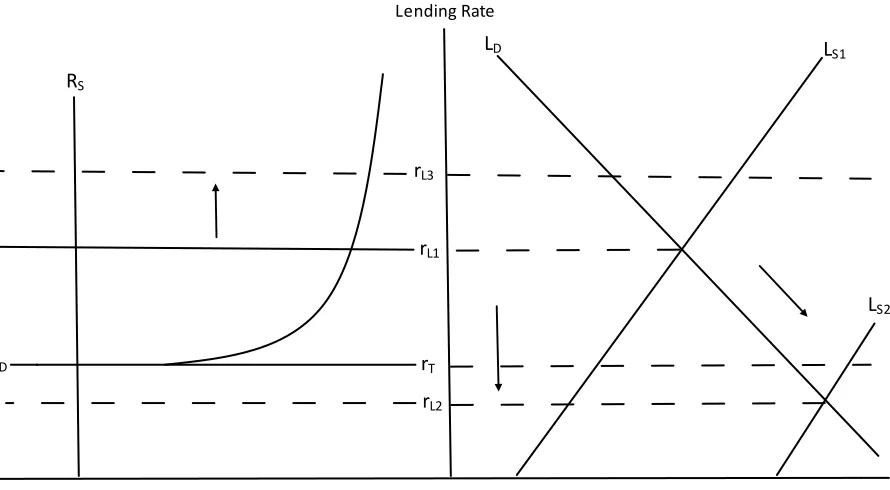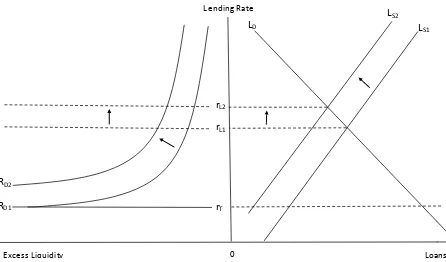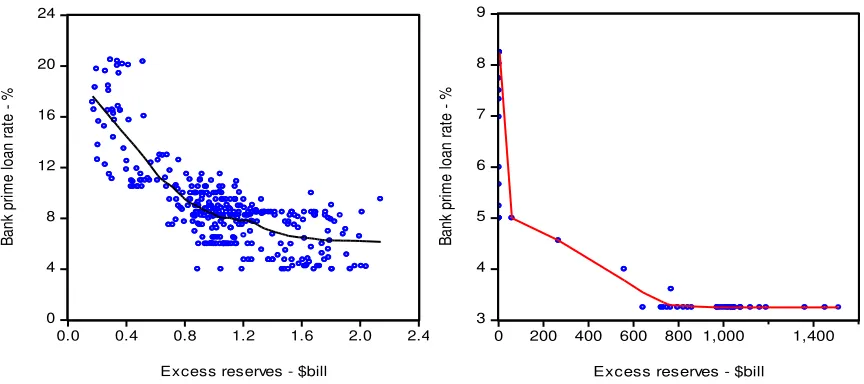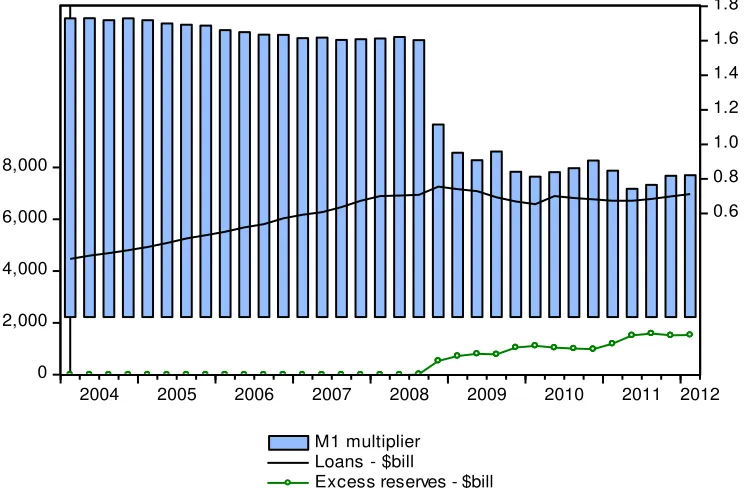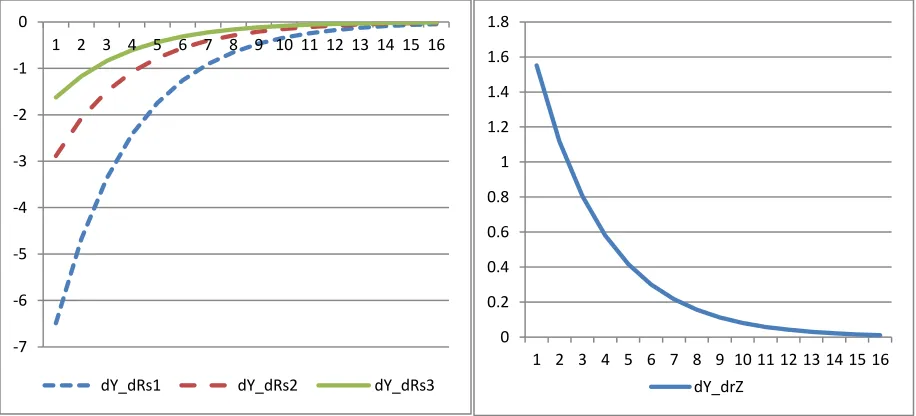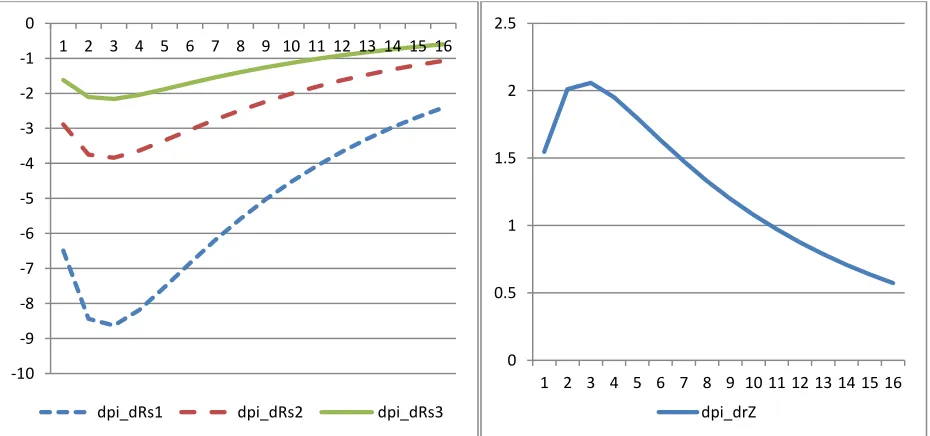Munich Personal RePEc Archive
The Non-Zero Lower Bound Lending
Rate and the Liquidity Trap
Khemraj, Tarron
New College of Florida
1 September 2011
Online at
https://mpra.ub.uni-muenchen.de/42030/
1
The Non-Zero Lower Bound Lending Rate and the Liquidity Trap
Tarron Khemraj, New College of Florida
Abstract
Most studies of the liquidity trap emphasize the zero bound benchmark policy rate. This paper integrates a non-zero lower bound lending rate and the traditional zero bound policy rate in a dynamic structural macroeconomic model that takes into consideration aggregate bank liquidity preference as a financial friction. The approach allows for analyzing the dynamic effects of quantitative easing and an interest rate policy. Once the non-zero lower limit is reached, increasing the benchmark policy rate marginally can have a positive effect on output. Expanding quantitative easing at the non-zero lower limit results in a negative effect on output. Increasing marginally the zero bound policy rate is better at stimulating inflation than quantitative easing. However, excessive tightening in a normal regime would result in the opposite effect.
Key Words: liquidity trap, quantitative easing, financial friction, excess liquidity
1. Introduction
The literature often recognizes the zero bound policy interest rate as an important feature
of the liquidity trap (Murota and Ono, 2012; Eggertsson, 2010; Krugman, 1998). This work
argues that there is also a non-zero minimum threshold lending rate existing along with the zero
bound benchmark funds rate. The paper integrates these two interest rates into a dynamic
structural macroeconomic model, which will allow us to analyze inflation and output dynamics
when the zero bound and non-zero bound rates are simultaneously binding1. The model presented herein has the following features. First, it has an augmented IS equation in keeping
with the empirical findings of Goodhart and Hofmann (2005). Second, it proposes a bank
reserves-loan equation (hereafter RL equation) similar in spirit to Khemraj and Proaño (2011).
These two equations allow us to solve for two endogenous variables – aggregate output and the
bank lending rate. Third, a recursive Phillips curve is added for the purpose of solving for the
time path of inflation.
1
2
Fundamental to RL equation is the idea of an aggregate bank liquidity preference curve.
Bank liquidity preference is introduced as a financial friction because the curve becomes flat at a
non-zero minimum threshold lending rate, signaling that bank loans and excess reserves are
perfect substitutes (Khemraj, 2010). This substitution takes place at an interest rate above zero
instead of the often emphasized substitution between government bonds and money at the zero bond rate of the classic liquidity trap (Eggertsson and Ostry, 2005)2. At this stage the money multiplier declines indicating that bank credit does not grow concomitantly with the expansion of
excess bank reserves, which have increased to unprecedented levels following three rounds of
quantitative easing. Introducing bank liquidity preference as a financial friction in a dynamic
macroeconomic model has not been done in the literature. The idea of a financial friction, as
introduced in this paper, has to do with the fact that a flat bank liquidity preference curve is
associated with bank disintermediation during the period when there is a binding minimum
threshold lending interest rate. Moreover, the minimum rate indicates that the market lending
rate is equal to the marginal cost of making new loans adjusted for the risk of borrower default.
This work models the minimum threshold lending rate as a mark-up over the marginal cost of
making loans and a probability of borrower default. Therefore, for the rest of the paper the terms
minimum mark-up threshold lending rate and non-zero lower bound lending rate will be used
interchangeably.
The paper proposes a reserve-loan equation (RL equation), which embeds a reciprocal
aggregate bank liquidity preference function. By introducing the RL equation the paper
integrates the proposed financial friction with the bank loanable funds market; and it embeds the
friction in a dynamic model which allows for studying output and inflation fluctuations given a
policy of monetary easing versus a policy of a marginal increase in the zero bound policy interest
rate. The rest of the paper is organized as follows. Using diagrams, section 2 illustrates the idea
of how the financial friction influences the bank loanable funds market. The name bank liquidity
2
3
trap (hereafter BLT) is used to represent this phenomenon. This section is followed by section 3
that derives the dynamic equations for output and inflation. Section 4 provides several stylized
facts pertinent to the discussion. Section 5 simulates the dynamic multipliers and section 6
concludes. An appendix is given in which the non-zero lower bound lending rate lending rate is
derived.
2. Diagrammatic Explanation of the Bank Liquidity Trap
Krugman (1998, p.148) defines the liquidity trap as: “a situation in which conventional
monetary policies have become impotent, because nominal interest rates are at or near zero:
injecting monetary base into the economy has no effect, because base and bonds are viewed by the private sector as perfect substitutes.” This work extends this idea by including aggregate bank liquidity preference in the narrative of the liquidity trap. The BLT has the following
features: (i) the trigger is a fall in asset prices that reduces banks’ net worth; (ii) the diminished net worth negatively shocks banks’ liquidity preference; (iii) central bank liquidity injection pushes the market lending rate down towards the risk-adjusted marginal cost of loans (the
mark-up lending rate); and (iv) the loan market is pushed into disequilibrium where the smark-upply of loans
is less than the demand for loans. Richard Koo’s (2009) balance sheet recession thesis also
underscores the collapse of asset prices. Koo’s analysis focuses on household and firms repaying
old debt and therefore reducing their consumption and investment. The thesis of this paper is that
the crash in asset prices and intervention by the central bank pushes the lending rate towards the
minimum mark-up threshold interest rate that makes excess reserves and loans perfect substitutes
since the market lending rate is equal to the risk-adjusted marginal cost of lending.
The diagrammatic analysis would be made clearer once we consider the following
equations. The first equation is the banks’ demand for excess liquidityRD
or the liquiditypreference function. The supply of reserves is determined by the central bank independently of
the loan raterL. Given the empirical liquidity preference in section 4, the liquidity demand
function is modeled as a reciprocal function. Hence the interest rate enters the equation as1/rL.
The reciprocal of the inverse liquidity preference curve is the non-zero lower-bound loan interest
rate threshold, at which point the curve is flat (equation 7). The other interest rate is the rate
4
preference function because when asset prices fall bank reserves come under strain even when
the bank is using some off balance sheet conduit (see Gorton and Metrick, 2010).
(1/ , , )
D L E B
R r r N (1)
The following partial derivativesRD/ rL 0, RD/ rE 0and RD/NB 0are
assumed to exist. The negative relationship between RDand rLis obvious from a reciprocal
liquidity preference function. An increase in the interest rate on excess liquidity (rE) encourages
banks to hoard more reserves above the required level. The positive relationship between RDand
B
N needs some explanation. In good times banks need liquidity to fund loans and asset
purchases. In bad times liquidity will tend to fall – assuming no central bank intervention – as
asset prices decline and banks have to settle transactions with those withdrawing funds in
traditional deposits or money market accounts. Therefore, a positive relationship is assumed to
hold between net worth and reserves. The second equation specifies the demand for loans and the
third the supply of loans.
( , )
D L FH
L r N (3)
( , , )
S L E
L r r (4)
FH
N is the net worth of firms and households. is the probability that borrowers will default on loans. The following partial derivatives are assumed to hold:LD/ rL 0,LS / rL 0,
/ 0
D FH
L N
,LS / rE 0andLS / 0.
As noted earlier, equation 1 notes that the bank liquidity preference curve is modeled as a
reciprocal function with an asymptote being the minimum threshold interest rate. Following
Khemraj (2010), this paper assumes that the threshold rate or non-zero lower-bound rate is a
mark-up interest rate. Moreover, the threshold (rT) determines the flat segment of the liquidity
preference curve. In a regime of a binding threshold, we assume that banks take excess reserve
and loans as perfect substitutes – hence the flat segment of the curve. The mark-up rate can be
5
(1 ) ( ) (1 )(1 1/ )
F S
T
r R mc
r
aN
(5)
The equation includes several parameters that may cause the lower-bound threshold or
asymptote to shift. The first is the marginal cost of lending (mc) that would include a team of
analysts and workers who are originating new loans and managing portfolios of old ones. was defined earlier – it is the probability borrowers will default. is the percentage of reserves held
as special deposits at the Federal Reserve, while 1is the percentage of reserves traded in the overnight funds market. As1approaches 1 the money market is again functioning as in normal times. rFis the federal funds rate that is subjected to liquidity effects – hence the reason
for writing it as r RF( S). The liquidity effect can be expressed symbolically as the following
derivativer RF( S)0whereRSis the level of reserves supplied by the central bank as it buys up various financial assets to ease the strain in the money and capital markets. The negative
relationship is based on the idea that if the Fed wants to lower the funds rate target it would need
to supply reserves; and if it wishes to increase the target it must tighten liquidity3. The loan elasticity of demand is given by the term a and N expresses the number of banks in the system.
Figure 1 summarizes the core thesis of the bank liquidity trap. The decline in the price of
assets cause the liquidity preference curve to shift fromRD1toRD2, thereby decreasing the level
(for the given loan rate) of liquidity in the banking system from R1toR2. The central bank is now
forced to intervene by pumping excess reserves into the system4. The loan rate declines as the funds rate falls through the liquidity effect. There is no shift in the demand for and supply of
loans. As liquidity is injected the market loan rate falls towards the threshold mark-up rate. At
this point, the rate reaches the non-zero lower bound and the differential between desired loan
demand and actual supply is farthest apart. The desired demand for loans isD*but L*is
supplied by the banking system. The economy has now entered a bank liquidity trap.
3
Open mouth operations would also tend to influence the funds rate in the very short run. Eventually the liquidity effect takes over in longer period observations with which this paper is mainly devoted.
4
6 Figure 1. The Bank Liquidity Trap
Figure 2 develops the idea further by showing that an outward shift in loan supply
beyondD*cannot occur because it will drive the market rate below the threshold mark-up
lending rate. It implies that the market interest rate rL2is lower than the risk adjusted marginal
cost of lending; hence banks will be lending to make a loss. This is logically impossible because
banks will not want to drive the market interest rate below marginal cost adjusted for risk of
borrower default. To understand this point further, consider that the Fed has injected enough
liquidity such that the supply of reserves is given by the vertical lineRS, which intersects the flat
segment of the liquidity preference curve. Once we are in the regime of the BLT, banks will not
extend loans by shifting outwards supply because this causes the market loan rate to fall further
torL2. Therefore, the BLT can only be characterized by a situation where the non-zero lower
bound lending rate is reached and the desired demand for loans is greater than the actual supply.
On the other hand, excessive monetary tightening can stifle credit demand should it
pressure the market interest rate above equilibrium. This could occur at a market rate such asrL3
7
in figure 2. If liquidity is drained from the system until it gives rise torL3(as shown by equation
5), then the desired supply of loans will now be less than the actual demand for loans. At this
point the economy exited the BLT and entered into a regime in which investment demand is
[image:8.612.94.539.252.497.2]constrained. Here the parameter would be negative to signal a downward pressure in the lending rate5. It would appear therefore that monetary policy has to walk a balancing act between tightening and easing such that the raterLis attained.
Figure 2. In a BLT Banks will not Shift Loan Supply Outwards
One of the developments after the 2007-08 financial crisis was the payment of interest
rate on excess reserves that banks hold at the Fed. In order to understand how this affects the
model, consider equations 3 and 4. There we see the interest on excess reserves enter both the
liquidity preference equation and the loan supply equation. Given the assumed partial
derivatives, the loan supply function will shift inward and the liquidity preference curve will
5
Oligopolistic banks would tend to quicker to adjust lending rate upward than downward; hence the parameter value will be different in the two regimes. The study of an investment demand constrained regime is beyond the scope of this paper. For an analysis of the investment demand constraint in developing economies, and in an open economy context, see Rodrik and Subramanian (2009).
8
shift outward for an increase inrE(see figure 3). The effect is that it reduces the intermediation of
loans and increases the level of liquidity. In other words, the policy shifts banks’ preference in favor of excess liquidity. However, the policy would tend to increase the lending rate owing to
its effect on loan supply. In light of the significant decline in the prime lending rate it appears
that the effect of interest on excess reserves has not had this effect to date. The lending rate,
[image:9.612.90.536.259.521.2]however, could increase as part of an exit strategy if such a strategy involves increasingrE.
Figure 3. Increase in Interest on Excess Reserves
3. Output and Inflation Dynamics in a BLT
The model presented above needs to be embodied in a macroeconomic framework in
order to analyze how aggregate output and prices behave when the economy is in a BLT. The
framework is based on three equations similar to Khemraj and Proaño (2011). The first equation
is a reserve-loan equation (RL equation) that embeds a reciprocal liquidity preference function,
the second an augmented IS equation, and the third a recursive equation of the Phillips curve.
The IS equation is augmented to take into consideration loan supply of banks. Goodhart and
9
Hofmann (2005) noted that the IS equation should be augmented to include asset prices and
monetary aggregates. This work does not include asset price in the equation because it is not
needed for the problem we seek to address. However, the IS equation can easily be augmented
with borrower net worth so as to analyze how a net worth crash affects output and prices over
time. Including loan supply into the IS equation provides a specification that addresses the problem this paper sets itself addressing.
The RL equation
Assume the lending rate adjusts according to the following specification
1 [ ( , ) ( , , )]
Lt Lt D L FH S L E
r r L r N L r r . However, for the purpose of the analysis at hand we do
not need the shifts in supply and demand for loans. The study will focus only on changes in
interest rate owing to movements along the supply and demand curves. Therefore, the
specification we need for the analysis is given by equation 6. It should be noted that the
framework is general enough for studying output and price dynamics owing to the shift variables
in equations 3 and 4.
1 ( )
Lt Lt D S
r r L L (6)
Assume also that the aggregate bank liquidity preference curve takes the shape of a reciprocal
function with the asymptote representing the minimum mark-up interest raterT. The parameterl
indicates the liquidity effect (0 l 1). For the remainder of this paper assume thatl 1. The stylized facts will show later that this assumption is consistent with an empirical chart of bank
liquidity preference.
l
L T St
r r R (7)
As noted earlier, in the BLT the supply of loans is the main constraint as the desired demand is
unfulfilled at a specific lending interest rate. Therefore, equation 6 can be rewritten as
1
Lt Lt S
r r L . Note that0 1since in the BLT regime interest rate adjustment will be upward given no intervention by the central bank. Substituting equation 6 into 7 and expressing
St
10
1 1
1
( )
St T Lt St
L r r R
(8)
Output dynamics
The augmented IS equation is given by equation 9, while the recursive Phillips curve is
denoted by equation 10. Yt= aggregate level of output, t= inflation rate, and Y*= trend output.
r
= the interest elasticity of output, L= the loan elasticity of output, = a measurement of
inflation persistence, and = a measurement of the responsiveness of inflation to the output gap. Note thatris a negative coefficient as the empirical finding of Goodhart and Hofmann (2005) found.
1
( )
t r L t L S
Y r L (9)
*
1 ( )
t t Yt Y
(10)
We now have the basic equations to derive the structural equation which gives the motion of
output over time. The relationship between the federal funds rate and excess liquidity also
follows a reciprocal function, which becomes flat at the zero bound benchmark interest rate. This
relationship will be made obvious in the stylized facts section. Therefore, the expressionr RF( S)in
equation 5 can be rewritten as a model given by equation 11.
1
F Z St
r r R (11)
Substituting equation 11 into equation 5 allows us to rewrite the threshold as
1
(1 )( )
(1 )(1 1/ )
Z St
T
r R mc
r
aN
Note thatrZ 0as is often noted in the case in a liquidity trap. This is the policy interest rate which the Federal Reserve can increase by policy actions. It is the threshold in equation 11
because the benchmark policy rate has reached its zero bound. This rate must be distinguished
11
benchmark interest rate,rTgives the non-zero lower bound lending rate. Substituting forLStinto
the IS equation gives
1
1 1
( ) L( ) L
t r Lt t T Lt St
Y r r r R
(12)
Note that from the Phillips curve equation we obtaint1t2Yt1assuming stable
parameters. If we substitute this dynamic equation into equation 12 it will give us the following
model that shows how output evolves over time.
1 1 ( 1)
L L
t r t T Lt St
Y Y r r R
(13)
Equation 13 suppresses the termr(rLtt2)which will be reintroduced later when we analyze the inflation dynamics. We now need to substitute equations 11 and 5 into equation 13.
Rearranging and suppressing the expressions ( L/ )rLt1and [ L/ (1)(1 1/ aN mc)] will
give us the final equation (and taking into consideration the negativer) that we can use to analyze QE and an interest rate policy in a BLT.
1 1
(1 ) (1 )
(1 )(1 1/ ) (1 )(1 1/ )
L L
t r t Z St
Y Y r R
aN aN
(14)
Equation 14 allows us to derive and simulate dynamic multipliers for both policies (see
Appendix 1). The interest rate policy would involve increasingrZsince the benchmark policy rate
is close to zero. Quantitative easing policy would involve increasingRSt. The term r
determines the stability of the equation. It would be necessary to solve for the time path of the
model in order to analyze how the model parameters( , L, r, , , , , , )a N influence the
relative effectiveness of the two policies. The degree of responsiveness of aggregate output to
loans (measured byL) is critical in determining a positive response in periodt0. and
affect only the effectiveness of QE, while the percentage of reserves () held in the Fed is
critical for both policies. The speed of lending rate adjustment is crucial for both policies.
12
response int0. One result that might seem counterintuitive is the probability of loan default (
). An increase leads to a bigger response int0. This feature only occurs in a BLT. If the
market rate is above equilibrium we would have the opposite result wherereduces supply of credit. Since the lending rate is at its threshold, the higher risk would signal a higher interest rate
and therefore tend to stimulate intermediation by causing an upward movement along the loan
supply curve (see figure 1).
Price Dynamics
In order to obtain the dynamic price equation, substitute the output solution into the
Phillips curve. This results in the following model in which the term r 2Yt1is suppressed. For
the purpose of this work assume that the two roots are real, distinct and less than one.
1
1 2
(1 ) (1 )
(1 )(1 1/ ) (1 )(1 1/ )
L L
t t r t rZt RSt
aN aN
(15)
Using the method of lag operator, the inverse characteristic equation is given as the following.
2
1 2
(1L r L) (1 L)(1 L); 11and2 1
This allows us to rewrite Equation 15 as
1 1 1
1 2
(1 ) (1 )
(1 ) (1 )
(1 )(1 1/ ) (1 )(1 1/ )
L L
t L L rZt RSt
aN aN
(16)
4. Stylized Facts
Let us now take a look at the empirical evidence for the existence of a non-zero lower
bound loan interest rate and a zero bound policy rate in a bank liquidity preference framework.
Figure 4 presents a scatter plot of the prime loan interest rate and excess reserves. The plot tends
to confirm a reciprocal shape of the bank liquidity preference curve for the loan rate-excess
reserves space. The reciprocal or the non-zero lower bound rate before the subprime crisis occurs
13
behavior; this time the lower bound threshold declines to approximately 3.25%. The zero bound
benchmark policy rate is an important component of the theoretical model proposed in this work.
Therefore, we must establish this zero bound with a liquidity preference in the space of excess
reserves and the effective federal funds rate. Figure 5 presents the second liquidity preference
curve. Prior to the subprime crisis the lower bound threshold of the effective federal funds rate
was well above zero. However, the threshold fell towards zero, approximately 0.16%, in the
[image:14.612.91.523.315.507.2]post-crisis period.
Figure 4. Bank liquidity preference vis-à-vis loan rate – monthly data 1980:1–2006:12 (left panel); 2007:1-2012:5 (right panel)
The liquidity preference curves were all extracted from scatter plots using the method of
locally weighted regressions with a smoothing parameter of 0.3 (see Cleveland, 1993; 1979).
Two outliers were removed – those are September 2001 and August 2003. Removing the outliers
does not affect the pre-2007 interest thresholds. Including the outliers makes the threshold rate
more conspicuous. Data for the Loess fit and figure 6 came from the Federal Reserve Economic
Data (FRED). Figure 6 shows the money multiplier over the period 2004 to 2012: Q1, total loans
and leases and excess reserves. The multiplier has declined significantly as excess reserves
0 4 8 12 16 20 24
0.0 0.4 0.8 1.2 1.6 2.0 2.4 Excess reserves - $bill
B
an
k
pr
im
e
lo
an
r
at
e
-
%
3 4 5 6 7 8 9
0 200 400 600 800 1,000 1,400 Excess reserves - $bill
B
an
k
pr
im
e
lo
an
r
at
e
-
14
expand. As excess reserves rise aggregate loans and leases remain flat, hence being consistent
with the thesis herein that excess reserves and loans are substitutes in a BLT. However, this
substitute relationship would tend to switch to a complement one outside of the regime of a BLT.
[image:15.612.91.522.221.406.2]Figure 5. Bank liquidity preference vis-à-vis the effective federal funds rate – monthly data 1980:1 – 2006:12 (left panel); 2007:1 to 2012:5 (right panel)
Figure 6. M1 money multiplier (right axis) for quarterly data 2004: Q1 to 2012: Q1
0 4 8 12 16 20
0.0 0.4 0.8 1.2 1.6 2.0 2.4 Excess reserves - $bill
E ff ec tiv e F ed er al F un ds R at e - % 0 1 2 3 4 5 6
0 200 400 600 800 1,000 1,400 Excess reserves - $bil
E ff ec tiv e fe de ra l f un ds r at e - % 0 2,000 4,000 6,000 8,000 0.6 0.8 1.0 1.2 1.4 1.6 1.8
2004 2005 2006 2007 2008 2009 2010 2011 2012
M1 multiplier Loans - $bill
[image:15.612.71.443.463.707.2]15
5. Model Simulation
The simulations attach numerical values for the derived multipliers in Appendix 1. The
following parameter values are used in the model simulation:r 0.8, 0.9,L 0.6, 0.3,
0.2
, 0.05,1 0.9, 2 0.4 ,6.52, 6.36and1 1/ aN1. In the case of the latter
we assume N is so large that the expression representing market power is equal to one. Figure 7
graphs the dynamic multipliers for output change given the change in QE and the policy rate
over sixteen periods after time t = 0. The left panel shows the response of output given an
expansion of monetary easing. Three hypothetical levels of excess reserves are used. The
dynamic multipliers shift inward as the level of reserves increase (RS = 2, RS = 3and RS = 4) at
the binding minimum mark-up lending rate. Overall, the response is negative and tends to move
back to the zero equilibrium. The right panel shows the response of output given a marginal
increase in the zero bound benchmark policy rate. According to the model presented here, the
increase in the interest rate has a positive impact coefficient and eventually dampens towards
[image:16.612.72.530.460.668.2]equilibrium.
Figure 7. Dynamic response of output to a change in RSand rZ; left panel showsY/RSand right
panel showsY /rZfor sixteen future periods
Figure 8 graphs the multipliers showing the response of inflation given a monetary
expansion (left panel) and an increase in the zero bound policy (right panel). The results suggest
-7 -6 -5 -4 -3 -2 -1 0
1 2 3 4 5 6 7 8 9 10 11 12 13 14 15 16
dY_dRs1 dY_dRs2 dY_dRs3
0 0.2 0.4 0.6 0.8 1 1.2 1.4 1.6 1.8
1 2 3 4 5 6 7 8 9 10 11 12 13 14 15 16
16
that monetary easing is deflationary in a BLT regime. The impact multiplier gets less
deflationary as the level of excess reserves increase at the minimum lending rate (RS = 2, RS = 3
and RS = 4). This result is different from other approaches that suggest that the central bank
needs to commit to quantitative easing in order to drive the real interest rate into the negative
territory. However, the liquidity preference of banks means that pursuing QE would be consistent with a falling money multiplier. The derived dynamic multipliers suggest that prices
have to be stimulated through lending (L) given the responsiveness of inflation to the output gap (). It also suggests that liquidity preference of banks must decline (or the percentage 1 must rise). The output response is positive with an impact multiplier of just over 1.5%.
[image:17.612.73.538.365.583.2]Subsequent multipliers increase until period 4 and dampen towards equilibrium.
Figure 8. Dynamic response of inflation to a change in RS and rZ: left panel shows/RSand
right panel shows /rZfor sixteen future periods
6. Conclusion
This work proposed a model that integrates excess liquidity and imperfect bank
competition into a dynamic structural macroeconomic framework in order to study how
quantitative easing and an interest rate policy affect output and prices in a liquidity trap, which
-10 -9 -8 -7 -6 -5 -4 -3 -2 -1 0
1 2 3 4 5 6 7 8 9 10 11 12 13 14 15 16
dpi_dRs1 dpi_dRs2 dpi_dRs3
0 0.5 1 1.5 2 2.5
1 2 3 4 5 6 7 8 9 10 11 12 13 14 15 16
17
this paper labels a bank liquidity trap. In this study the non-zero lower bound lending rate was
combined with the conventional zero bound rate through the liquidity preference of banks. The
BLT is precipitated by a shock to bank liquidity preference because of the collapse of financial
asset prices. Subsequent central bank intervention, beyond easing the short-term liquidity freeze,
serves to push the market lending rate towards the risk-adjusted marginal cost of lending, at which point excess reserves and loans are perfect substitutes. Hence, the excess liquidity
phenomenon reflects the idea that the market lending rate is equal to the risk-adjusted marginal
cost of lending. This is different from Murota and Ono (2012) who proposed a model in which the excess bank liquidity signals that households’ marginal utility of cash is greater than that of consumption. The thesis is also different from the explanation given by Keister and McAndrews (2009) who argued that excess liquidity is merely a passive feature of the Fed’s quantitative easing.
The paper proposed the RL equation that is combined with an augmented IS equation and
a traditional Phillips curve. Embedded in the RL equation is a reciprocal function of aggregate
bank liquidity preference, which was then included as a financial friction in a broad
macroeconomic model. This work limited itself to analyzing the implication of bank liquidity
preference for an interest rate policy versus a quantitative easing policy during a bank liquidity
trap in a dynamic setting. However, the framework is general enough that the IS equation can be
expanded to include borrower net worth. The framework can also be extended to study output
and price dynamics in an investment demand constrained regime where the minimum threshold
lending rate is above the equilibrium loanable funds rate. This regime – a subject of future
18
References
Bernanke, Ben and Alan Blinder (1988). “Credit, money and aggregate demand.” American Economic Review, Vol. 78 (2), Papers and Proceedings of the One-Hundredth
Annual Meeting of the American Economic Association, 435-439.
Cleveland, William (1993). Visualizing Data. Summit, NJ: Hobart Press.
Cleveland, William (1979). “Robust locally weighted regression and smoothing scatterplots.”
Journal of the American Statistical Association, Vol. 74: 829-836.
Eggertsson, Gauti (2010). “Liquidity trap.” In Monetary Economics, Durlauf, Steven and Laurence Blume (eds.). New York: Palgrave Macmillan.
Eggertsson, Gauti and Jonathan Ostry (2005). “Does excess liquidity pose a threat in Japan.”
IMF Policy Discussion Paper 05/5, International Monetary Fund.
Enders, Walter (2010). Applied Econometric Time Series, 3ed. Hoboken, NJ: John Wiley and Sons.
Freixas, Xavier and Jean-Charles Rochet (2008). Microeconomics of Banking, 2nd edition. Cambridge, MA: MIT Press.
Goodhart, Charles and Boris Hofmann (2005). “The IS curve and the transmission of monetary policy: is there a puzzle?” Applied Economics, Vol. 37 (1), 29-36.
Gorton, Gary and Andrew Metrick (2010). “Haircuts.” Federal Reserve Bank of St. Louis Review, November/December.
Hamilton, James (1994). Time Series Analysis. Princeton, NJ: Princeton University Press.
Keister, Todd and James McAndrews (2009). “Why are banks holding so many excess reserves?”Current Issues in Economics and Finance, Vol. 15 (8): 1-10.
Khemraj, Tarron (2010). “What does excess bank liquidity say about the loan market in Less Developed Economies?” Oxford Economic Papers, Vol. 62 (1): 86-113.
Khemraj, Tarron and Christian R. Proaño (2011). “Excess bank reserves and monetary policy with a lower-bound lending rate.” Working Paper 04/2011, Department of Economics, New School for Social Research.
Koo, Richard (2009). The Holy Grail of Macroeconomics: Lessons from Japan’s Great
Recession. Hoboken, NJ: John Wiley & Sons.
Krugman, Paul (1998). “It’s baaack! Japan’s slump and the return of the liquidity trap.”
Brookings Papers on Economic Activity, Vol. 29 (2), 137-206.
19
Ogawa, Kazuo (2007). ‘Why Japanese banks held excess reserves: the Japanese experience of the late 1990s.’ Journal of Money, Credit and Banking, Vol. 39 (1): 241-257.
Ono, Yoshiyasu (2011). “The Keynesian multiplier effect reconsidered.” Journal of Money, Credit and Banking, Vol. 43 (4): 787-794.
Rodrik, Dani and Arvind Subramanian (2009). “Why did financial globalization disappoint?”
20
Appendix 1
Derivation of the Minimum Mark-Up Rate
Equation 1A is the representative bank’s profit function (for the ith bank) that is assumed
to be concave in loans to private agents (Li), deposits (Di), excess reserves held in special
deposits at the Federal Reserve (RSi), and excess reserves lent out in the interbank federal funds
market (RFi) at the rate of interestrF. Equation 2A is the bank’s balance sheet constraint.
represents the probability of borrower default; therefore as increases there is a penalty on the profit the bank can make. ( )c Li denotes the costs of monitoring existing loans and making new
loans. This derivation follows the procedure of Freixas and Rochet (2008) and Khemraj (2010).
i (1 ) ( )r L LL i (1 )r RF Fi r R RS( S) Si r D DD( ) i c Li( )
(1A)
i Fi Si i i
zD R R L D (2A)
The interest rate earned on special deposits at the fed isrS. The percent of excess reserves held in
special deposits is and 1percent is loaned out in the funds market. This is obviously a simplification since the profit function does not penalize the bank for having a shortage of
reserves. Omitting the latter feature will not affect the derived threshold lending interest rate. The
level of required reserves is represented byzDiwhere z= required reserve ratio. Except the funds
rate, the key interest rates in the model are written in inverse function forms. r LL( )= loan rate;
( )
D
r D = deposit rate; and r RS( S)= interest earned on depositing excess reserves at the fed.
Solving the balance sheet constraint for RFiand substituting into equation 1A gives the
following profit function from which we obtain the first order condition to derive the threshold
equation.
i [(1 ) ( ) (1r LL ) ]r LF i [r RS( S) (1 ) ]r RF Si [ ( )r DD rF(1 )(1 z D)] i c Li( )
A Cournot equilibrium is assumed for the purpose of the derivation. In this equilibrium, the ith
21 other words, for the ith bank( ,* *, *)
i Si i
L R D solves the profit-maximization problem. The aggregate
quantity of loans, deposits and reserves at the Fed, respectively, demanded by the entire banking
sector are described in equation 3A.
i j
i j
L L L
; S Si Sji j
R R R
; i ji j
D D D
(3A)The first-order condition after maximizing the profit function is described by equation
4A. mc= the marginal cost of monitoring existing loans and screening new ones (ormcc Li( )).
The market demand curve the bank faces is downward sloping, hence the elasticity of demand
denoted by the following expression:a r L rL ( ) /L L. The symbol a is the elasticity of demand
for loans. There is a unique equilibrium in which bank i assumes * */
i
L L N, where N denotes
the number of commercial banks that makes up the banking sector. The use of N weighs each bank equally. This is clearly an unrealistic assumption for the purpose of making the mathematics tractable. Nevertheless, the simplification does not change the conclusion of the model. The
expression r LL( )represents the first derivative of the loan rate with respect to L and it is simply
the inverse ofL r( )L . This allows us to obtainr LL( ) 1/ L r( )L . If we substitute this expression
and the elasticity into equation 4 we obtain the equation showing the mark-up over marginal cost
and the funds rate adjusted for the probability of default. This is given by equation 5A.
(1 ) ( ) (1 ) ( ) (1 ) 0
i
L L i F
i d
r L r L L r mc
dL
(4A)
(1 ) (1 1/ )
(1 )
F L
r mc
r aN
(5A)
Rearranging equation 5A gives the minimum mark-up rate that we call the threshold
interest rate, rT(equation 6A). The mark-up is dependent on the inverse of the product of N and
the market elasticity of demand (a) for loans. N=1 describes the case of a monopoly where the
mark-up is highest, while as N one bank has an infinitesimal share of the market; the equilibrium approaches the purely competitive state in which the mark-up approaches zero. In
22 therefore can be written as ( *)
F
r R with the effect being measured by the derivativer RF( ), which
is negative thus capturing the trade-off between high liquidity and low interest rate or low
liquidity and high interest rate. This mechanism allows the market interest rate to rise above the threshold at which point the banks’ liquidity preference curve is flat, thus indicating that liquidity effect is zero. Therefore, the threshold loan rate occurs when all funds market liquidity effects
have evaporated. When this occurs the market loan rate is equal to the risk-adjusted marginal
cost of lending. Banks therefore become neutral between hoarding excess reserves and making
loans.
* (1 ) ( )
(1 )(1 1/ )
F T
r R mc
r aN
(6A)
Derivation of the Output Multipliers
Equation 14 presented the dynamic structural output equation. Assume an initial value for
output (Y0) and r 1. Using a recursive method given the initial value would result in a
solution. Enders (2010) provided a detailed discussion of the solution methods for these types of
dynamic equations. From equation 14 let
1
(1 ) (1 )(1 1/ )
L b aN and 2 (1 ) (1 )(1 1/ )
L b aN
A solution to equation 14 is
1 1
1
0 1 2
0 0
( ) ( ) ( )
t t
t i i
t r r Zt i r St i
i i
Y Y b r b R
(7A)7A allows us to obtain the following dynamic multipliers for i future periods given a change inrZ
23
1( )
i t i r Zt Y b
r
The dynamic multipliers showing the response in output over time for i future periods given a
change inRStin the present period are given as follows. The impact multiplier for period i = 0 is
0/ S 2
Y R b
. Note that the term can easily be 2
S
R eliminated from the expression. However, this
term is kept so as to analyze the impact of quantitative easing when there is a minimum mark-up
lending rate.
2 2( )
i t i r S St Y b R
R
Derivation of the Inflation Multipliers
Equation 15 presented the dynamic structural inflation model. From equations 15 let
3
(1 ) (1 )(1 1/ )
L b aN and 4 (1 ) (1 )(1 1/ )
L b aN
We can rewrite equation 16 as
1 1 1
1 2 3 4
(1 ) (1 )
t L L b rZt b RSt
(8A)
For the purpose of this work, we will assume that the roots are distinct, real and less than one.
Let us assume that the factor of the inverse characteristic equation can be expressed as follows
2
1 2
(1L r L) (1 L)(1 L); 11and2 1
Where
1 2 2 3 3
1 1 1 1
24
1 2 2 3 3
2 2 2 2
(1 L) 1 L L L ...
Using the method outlined in Hamilton (1994) where 1 2and applying the method of partial
fractions will result in the following operator:
1 1 2
1 2
1 2 1 2
1
( )
1 L 1 L (1 L)(1 L)
Therefore, we can rewrite equation 8A as
1 1 2 1 1 2 1
1 2 3 1 2 4
1 2 1 2 1 2 1 2
( ) ( )
t b rZt b RSt
L L L L
(9A)
Letc1 1/ ( 1 2); c2 2/ ( 1 2)
This allows for rewriting equation 9A as
2 2 3 3
1 2 3 1 1 2 2 3 1 1 1 2 2 3 2 1 1 2 2 3 3
1 1 2 2 1 3 3
1 2 4 1 1 2 2 4 1 1 1 2 2 4 2 1 1 2 2 4 3
( ) ( ) ( ) ( ) ...
( ) ( ) ( ) ( ) ...
t Zt Zt Zt Zt
St St St Tt
c c b r c c b r c c b r c c b r
c c b R c c b R c c b R c c b r
(10A)
Or taking the sum gives a solution:
1 1
1 3 1 1 2 2 4 1 1 2 2
0 0
( ) ( )
t t
i i i i
t Zt i St i
i i
b c c r b c c R
(11A)From Equation 11A we can obtain the following dynamic multipliers
3( 1 1 2 2)
i i
t i
Zt
b c c
r
2 4( 1 1 2 2)
i i
t i
S St
b c c R
R
The impact multipliers are as follows0 / rZ b c3( 1c2)and 2 0/ RSt b c4( 1 c R2) S
